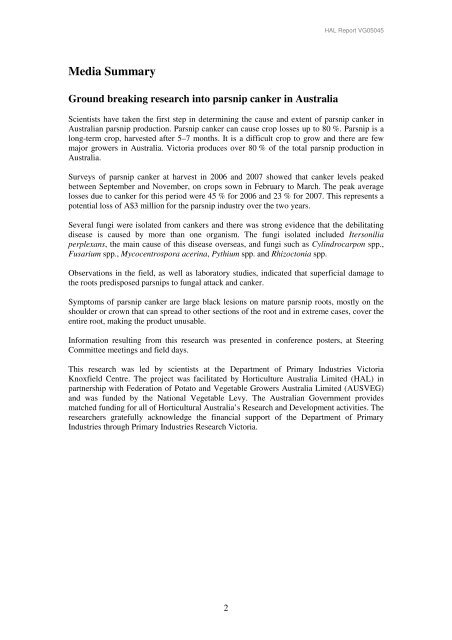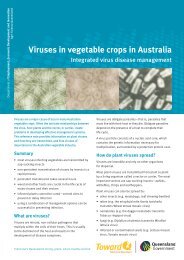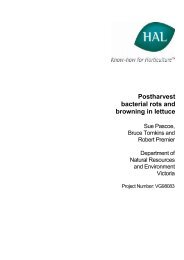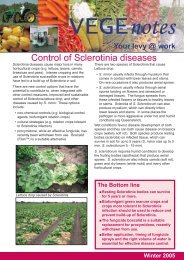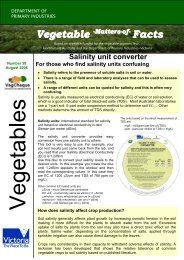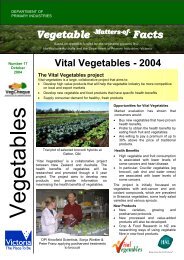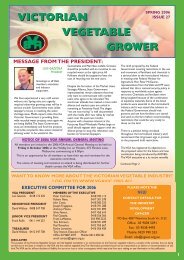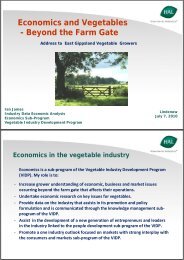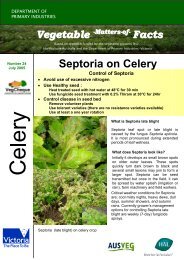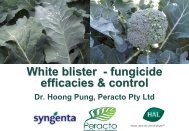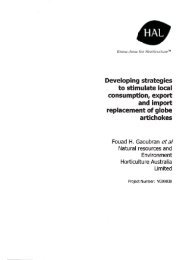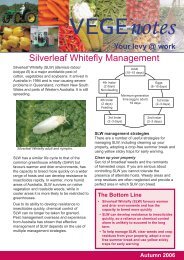HAL Report VG05045Media SummaryGround breaking research into <strong>parsnip</strong> <strong>canker</strong> in AustraliaScientists have taken the first step in determining the <strong>cause</strong> <strong>and</strong> <strong>extent</strong> <strong>of</strong> <strong>parsnip</strong> <strong>canker</strong> inAustralian <strong>parsnip</strong> production. Parsnip <strong>canker</strong> can <strong>cause</strong> crop losses up to 80 %. Parsnip is along-term crop, harvested after 5–7 months. It is a difficult crop to grow <strong>and</strong> there are fewmajor growers in Australia. Victoria produces over 80 % <strong>of</strong> the total <strong>parsnip</strong> production inAustralia.Surveys <strong>of</strong> <strong>parsnip</strong> <strong>canker</strong> at harvest in 2006 <strong>and</strong> 2007 showed that <strong>canker</strong> levels peakedbetween September <strong>and</strong> November, on crops sown in February to March. <strong>The</strong> peak averagelosses due to <strong>canker</strong> for this period were 45 % for 2006 <strong>and</strong> 23 % for 2007. This represents apotential loss <strong>of</strong> A$3 million for the <strong>parsnip</strong> industry over the two years.Several fungi were isolated from <strong>canker</strong>s <strong>and</strong> there was strong evidence that the debilitatingdisease is <strong>cause</strong>d by more than one organism. <strong>The</strong> fungi isolated included Itersoniliaperplexans, the main <strong>cause</strong> <strong>of</strong> this disease overseas, <strong>and</strong> fungi such as Cylindrocarpon spp.,Fusarium spp., Mycocentrospora acerina, Pythium spp. <strong>and</strong> Rhizoctonia spp.Observations in the field, as well as laboratory studies, indicated that superficial damage tothe roots predisposed <strong>parsnip</strong>s to fungal attack <strong>and</strong> <strong>canker</strong>.Symptoms <strong>of</strong> <strong>parsnip</strong> <strong>canker</strong> are large black lesions on mature <strong>parsnip</strong> roots, mostly on theshoulder or crown that can spread to other sections <strong>of</strong> the root <strong>and</strong> in extreme cases, cover theentire root, making the product unusable.Information resulting from this research was presented in conference posters, at SteeringCommittee meetings <strong>and</strong> field days.This research was led by scientists at the Department <strong>of</strong> Primary Industries VictoriaKnoxfield Centre. <strong>The</strong> project was facilitated by Horticulture Australia Limited (HAL) inpartnership with Federation <strong>of</strong> Potato <strong>and</strong> <strong>Vegetable</strong> <strong>Growers</strong> Australia Limited (AUSVEG)<strong>and</strong> was funded by the National <strong>Vegetable</strong> Levy. <strong>The</strong> Australian Government providesmatched funding for all <strong>of</strong> Horticultural Australia’s Research <strong>and</strong> Development activities. <strong>The</strong>researchers gratefully acknowledge the financial support <strong>of</strong> the Department <strong>of</strong> PrimaryIndustries through Primary Industries Research Victoria.2
HAL Report VG05045Technical summaryLittle or no research into <strong>parsnip</strong> <strong>canker</strong> has been undertaken in Australia despite the fact thatgrowers have reported persistent crop losses in spring-harvested crops <strong>of</strong> up to 80 % for 40years.This 24 month scoping study: Surveyed <strong>parsnip</strong> crops in the major cropping regions <strong>of</strong> Victoria, Tasmania <strong>and</strong> WesternAustralia to identify the <strong>extent</strong> <strong>of</strong> <strong>parsnip</strong> <strong>canker</strong> affecting production; Identified the <strong>cause</strong>s <strong>of</strong> <strong>parsnip</strong> <strong>canker</strong> in Victorian crops by conducting pathogenicitytests (Koch’s postulates) on fungi isolated from <strong>canker</strong>s; Used field trials to confirm pathogen trials; Determined that root damage predisposed <strong>parsnip</strong> roots to <strong>canker</strong>.Systematic surveys involving four growers in Victoria, as well as one in Tasmania <strong>and</strong> two inWestern Australia showed that <strong>parsnip</strong> <strong>canker</strong> was a major problem in Australia. In Victoria,where 80 % <strong>of</strong> Australian <strong>parsnip</strong>s are grown, <strong>parsnip</strong> <strong>canker</strong> accounted for losses <strong>of</strong> up to 45% in spring-harvested crops, <strong>and</strong> in one case, losses were over 85 %. This represented apotential loss <strong>of</strong> A$3 million for the <strong>parsnip</strong> industry over two years.Pathogenicity tests were conducted on fungi that were consistently isolated from diseased<strong>parsnip</strong> roots in Victoria. <strong>The</strong> confirmed overseas pathogens Itersonilia perplexans,Cylindrocarpon spp., Mycocentrospora acerina <strong>and</strong> Phoma spp. all <strong>cause</strong>d <strong>canker</strong>-likesymptoms on fresh <strong>parsnip</strong> roots. Other fungi such as Acremonium spp., Fusarium spp.,Microdochium spp., Pythium spp. <strong>and</strong> Rhizoctonia spp. <strong>cause</strong>d similar lesions. Pathogen trialsalso established that root damage predisposed <strong>parsnip</strong> to pathogen attack.Trials involving growers’ own seed <strong>and</strong> a commercial variety, Tusk, showed that there waspotential to alleviate <strong>canker</strong> levels using resistant cultivars. <strong>The</strong> use <strong>of</strong> Tusk reduced <strong>canker</strong>levels by 45 % compared to some <strong>of</strong> the growers’ own seed stocks.<strong>The</strong> effectiveness <strong>of</strong> metalaxyl-m in one out <strong>of</strong> three trials, in reducing <strong>canker</strong> incidence by77 %, reinforced the notion <strong>of</strong> root damage contributing to <strong>parsnip</strong> <strong>canker</strong>. In a second trial,metalaxyl-m reduced <strong>canker</strong> incidence by 34 %, although, in this case, it was not significantlydifferent from the control. <strong>The</strong>se results, as well as the pathogen tests, indicate that oomycetefungi such as Pythium spp. may have a role in predisposing <strong>parsnip</strong> roots to <strong>canker</strong>.Future directionsOur research has increased knowledge <strong>of</strong> <strong>parsnip</strong> <strong>canker</strong> but it has revealed how little weknow about this disease complex.Future investigations need to determine the: Predisposing nature <strong>of</strong> Pythium species <strong>and</strong> other pathogenic fungi; Biological succession <strong>of</strong> fungi on <strong>parsnip</strong> root to determine the time <strong>of</strong> initialinfection, by microbiological sampling; Influence <strong>of</strong> predisposing abiotic factors such as soil moisture, temperature, pH,nutrients <strong>and</strong> fertilization on <strong>canker</strong> development; Initiation <strong>of</strong> field infections, using targeted fungicides; Cultural, biological <strong>and</strong> alternative s<strong>of</strong>t chemical controls.3


